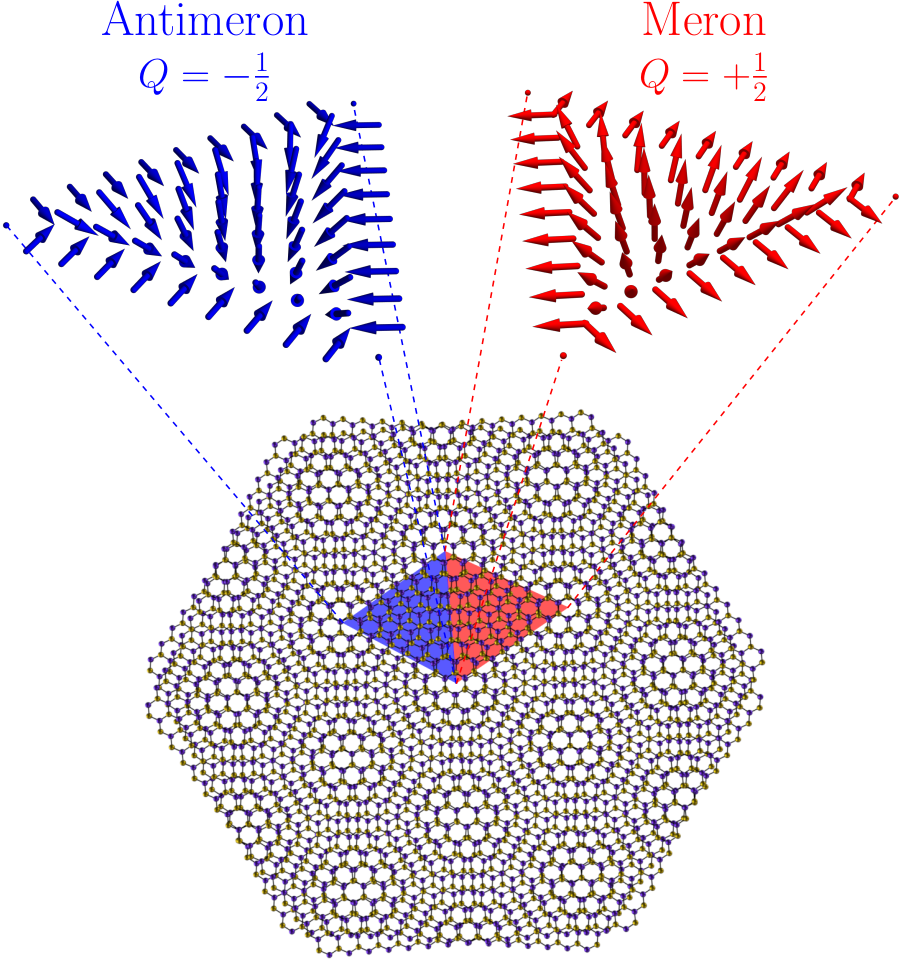Daniel Bennett

Dr Daniel Bennett
Member of St John's College
Visitor in Prof Artacho's group
TCM Group, Cavendish Laboratory
19 JJ Thomson Avenue,
Cambridge, CB3 0HE UK.

Research
My research is focused on phase transitions in atomically thin materials, namely thin films, superlattices and two-dimensional materials. More specifically, I study the competition between different phases that can occur in these materials, and how they influence each other. Some examples are:
- Ferroelectricity: perovskite thin films such as PbTiO3 and BaTiO3 exhibit ferroelectric domains which persist even in films which are a few unit cells thick. The polar mode competes with the rotations of oxygen octahedra (tilts), which can reduce or suppress ferroelectricity. Ferroelectricity is also suppressed by depolarizing electric fields in systems without any charge compensation at free surfaces. We have studied competition and coexistence between ferroelectricity and the formation of carriers at the surfaces, which may appear to screen the depolarizing field.
- Metal-Insulator Transitions (MITs) can occur at polar-nonpolar perovskite interfacesm such as LaAlO33/SrTiO3 (LAO/STO). A two-dimensional electron gas (2DEG) appears at the interface in order to screen the polar discontinuity. The formation of carriers is heavily influenced by the tilts that can occur in both materials, which competes biquadratically with the polar mode.
- Twistronics is the study of layered systems which can be tuned by introducing a relative twist angle or lattice mismatch between the constituent layers. These systems form stacking domains due to the competition between the out-of-plane van der Waals interactions and in-plane elasticity. I recently proposed that these domains are polar domains due to a local spontaneous polarization. The size and shape of the domains can be tuned using an electric field via the coupling to this spontaneous polarization.

In Plain English
Perhaps the greatest achievement of condensed matter physics is the ability to build and control devices comprised of just a few atoms. Graphene is a one-atom thick sheet of carbon which is 7 times lighter than air, 200 times stronger than steel, has countless applications in technology and has become a household name in the last decade.
My research revolves around the study of similar atomically thin materials: perovskites, which have become the superstars of the solar cell world with record efficiencies and low production costs, and two-dimensional (2D) materials known as transition-metal dichalcogenides (TMDs) which are similar to graphene and have applications in next-generation electronics, sensing and energy storage, to name a few. Together, perovskites and TMDs represent the future of technology on the nanoscale, and serve as a playground for observing and discovering new phenomena in physics.
While, the ability to synthesize devices on this scale is by itself amazing, what is truly impressive is the many ways in which these atomic systems can be tuned and controlled. The more control we have over these materials, the more possibilities there are in terms of applications in nanotechnology.
I study phase transitions in perovskite devices, using both theoretical and computational physics. While this may seem abstract at first, understanding the phase of a material is key in making use of its properties for applications in technology. For example, liquid-gas, which was the driving force the steam engine, and nonmagnetic-magnetic, which was the basis for memory storage in most computers. Phase transitions are also very important on the nanoscale, in superconductivity, energy and information technology, for example.
Featured Publications
- Flat and tunable moire phonons in twisted transition-metal dichalcogenides
Alejandro Ramos-Alonso, Benjamin Remez, Daniel Bennett, Rafael M. Fernandes, Hector Ochoa
[arXiv:2406.18779] - Plasmonic polarization sensing of electrostatic superlattice potentials
Shuai Zhang, Jordan Fonseca, Daniel Bennett, Zhiyuan Sun, Junhe Zhang, Ran Jing, Suheng Xu, Leo He, S.L. Moore, S.E. Rossi, Dmitry Ovchinnikov, David Cobden, Pablo. Jarillo-Herrero, M.M. Fogler, Philip Kim, Efthimios Kaxiras, Xiaodong Xu and D.N. Basov
[arXiv:2406.18028] - Ultrafast high-endurance memory based on sliding ferroelectrics
Kenji Yasuda, Evan Zalys-Geller, Xirui Wang, Daniel Bennett, Suraj S Cheema, Kenji Watanabe, Takashi Taniguchi, Efthimios Kaxiras, Pablo Jarillo-Herrero and Raymond Ashoori
Science 0, eadp3575 - Stacking-engineered ferroelectricty and multiferroic order in van der Waals magnets
Daniel Bennett, Gabriel Martínez-Carracedo, Xu He, Jaime Ferrer, Philippe Ghosez, Riccardo Comin and Efthimios Kaxiras
[arXiv:2405.20069] - Imaging topological polar structures in marginally twisted 2D semiconductors
Thi-Hai-Yen Vu, Daniel Bennett, Gayani Nadeera Pallewella, Md Hemayet Uddin, Kaijian Xing, Weiyao Zhao, Seng Huat Lee, Zhiqiang Mao, Jack B. Muir, Linnan Jia, Jeffrey A. Davis, Kenji Watanabe, Takashi Taniguchi, Shaffique Adam, Pankaj Sharma, Michael S. Fuhrer and Mark T. Edmonds
[arXiv:2405.15126] - 2D Nitride Ordered Alloys: A Novel Class of Ultra-Wide Bandgap Semiconductors
Raagya Arora, Ariel R. Barr, Daniel Bennett, Daniel T. Larson, Michele Pizzochero and Efthimios Kaxiras
[arXiv:2405.08966] - Band structure engineering using a moiré polar substrate
Xirui Wang, Cheng Xu, Samuel Aronson, Daniel Bennett, Nisarga Paul, Philip J.D. Crowley, Clément Collignon, Kenji Watanabe, Takashi Taniguchi, Raymond Ashoori, Efthimios Kaxiras, Yang Zhang, Pablo Jarillo-Herrero and Kenji Yasuda
[arXiv:2405.03761] - Polarization textures in crystal supercells with topological bands
Wojciech J. Jankowski, Daniel Bennett, Aneesh Agarwal, Gaurav Chaudhary and Robert-Jan Slager
[arXiv:2404.16919] - Asymmetric dynamical charges in two-dimensional ferroelectrics
Daniel Bennett and Philippe Ghosez
Physical Review B 110, L041101 (2024)
[arXiv:2404.10549] - Improper two-dimensional electron gas formation
Daniel Bennett, Pablo Aguado-Puente, Emilio Artacho and Nicholas Bristowe
[arXiv:2401.03016] - Photo-induced electronic and spin topological phase transitions in monolayer bismuth
Bo Peng, Gunnar F. Lange, Daniel Bennett, Robert-Jan Slager and Bartomeu Monserrat
Physical Review Letters 132, 116601 (2024)
[arXiv:2310.16886] - Twisted bilayer graphene revisited: minimal two-band model for low-energy bands
Daniel Bennett, Daniel T. Larson, Louis Sharma, Stephen Carr and Efthimios Kaxiras
Physical Review B 109, 155422 (2024)
[arXiv:2310.12308] - Theory of polarization textures in crystal supercells
Daniel Bennett, Wojciech J. Jankowski, Gaurav Chaudhary, Efthimios Kaxiras and Robert-Jan Slager
Physical Review Research 5, 033216 (2023)
[arXiv:2305.01404] - Polar meron-antimeron networks in strained and twisted bilayers
Daniel Bennett, Gaurav Chaudhary, Robert-Jan Slager, Eric Bousquet and Philippe Ghosez
Nature Communications 14, 1629 (2023) (Editor's Highlights)
[arXiv:2210.10786] - Coupling between tilts and charge carriers at polar-nonpolar perovskite interfaces
Daniel Bennett, Pablo Aguado-Puente, Emilio Artacho and Nicholas Bristowe
Physical Review B 106, 094106 (2022)
[arXiv:2206.13555] - Generalized relation between electromechanical responses at fixed voltage and fixed electric field
Daniel Bennett, Daniel Tanner, Philippe Ghosez, Pierre-Eymeric Janolin and Eric Bousquet
Physical Review B 106, 174105 (2022)
[arXiv:2206.13552] - Tunable photostriction of halide perovskites through energy dependent photoexcitation
Bo Peng, Daniel Bennett, Ivona Bravić, and Bartomeu Monserrat
Physical Review Materials 6, L082401 (2022) (Editor's Suggestion)
[arXiv:2206.00061] - Theory of polar domains in moiré heterostructures
Daniel Bennett
Physical Review B 105, 235445 (2022)
[arXiv:2203.01979] - Electrically tunable stacking domains and ferroelectricity in moiré superlattices
Daniel Bennett and Benjamin Remez
npj 2D Mater Appl 6, 7 (2022)
[arXiv:2108.10838] - Flexoelectric-like radial polarization of single-walled nanotubes from first-principles
Daniel Bennett
Electronic Structure 3 015001 (2021)
[arXiv:2005.02257] - Two-Photon Absorption in Monolayer MXenes
Gaozhong Wang, Daniel Bennett, Chuanfang (John) Zhang, Cormac Ó Coileáin, Meiying Liang, Niall McEvoy, Jing Jing Wang, Jun Wang, Kangpeng Wang, Valeria Nicolosi and Werner J. Blau
Advanced Optical Materials (2020): 1902021 - Electrostatics and domains in ferroelectric superlattices
Daniel Bennett, Maitane Muñoz-Basagoiti, Emilio Artacho
R. Soc. open sci. 7:201270
[arXiv:1912.13115] - Broadband saturable absorption and exciton-exciton annihilation in MoSe2 composite thin films
Gaozhong Wang, Aidan A. Baker-Murray, Xiaoyan Zhang, Daniel Bennett, Jing Jing Wang, Jun Wang, Kangpeng Wang, and Werner J. Blau
Optical Materials Express 9.2 (2019): 483-496 - Intensity-dependent nonlinear refraction of antimonene dispersions in the visible and near-infrared region
Gaozhong Wang, Sean Higgins, Kangpeng Wang, Daniel Bennett, Nina Milosavljevic, John James Magan, Saifeng Zhang, Xiaoyan Zhang, Jun Wang, and Werner J. Blau
Applied optics 57.22 (2018): E147-E153 - Nonlinear optical performance of few-layer molybdenum diselenide as a slow-saturable absorber
Gaozhong Wang, Guangxing Liang, Aidan A. Baker-Murray, Kangpeng Wang, Jing Jing Wang, Xiaoyan Zhang, Daniel Bennett, Jing-Ting Luo, Jun Wang, Ping Fan, and Werner J. Blau
Photonics Research 6.7 (2018): 674-680